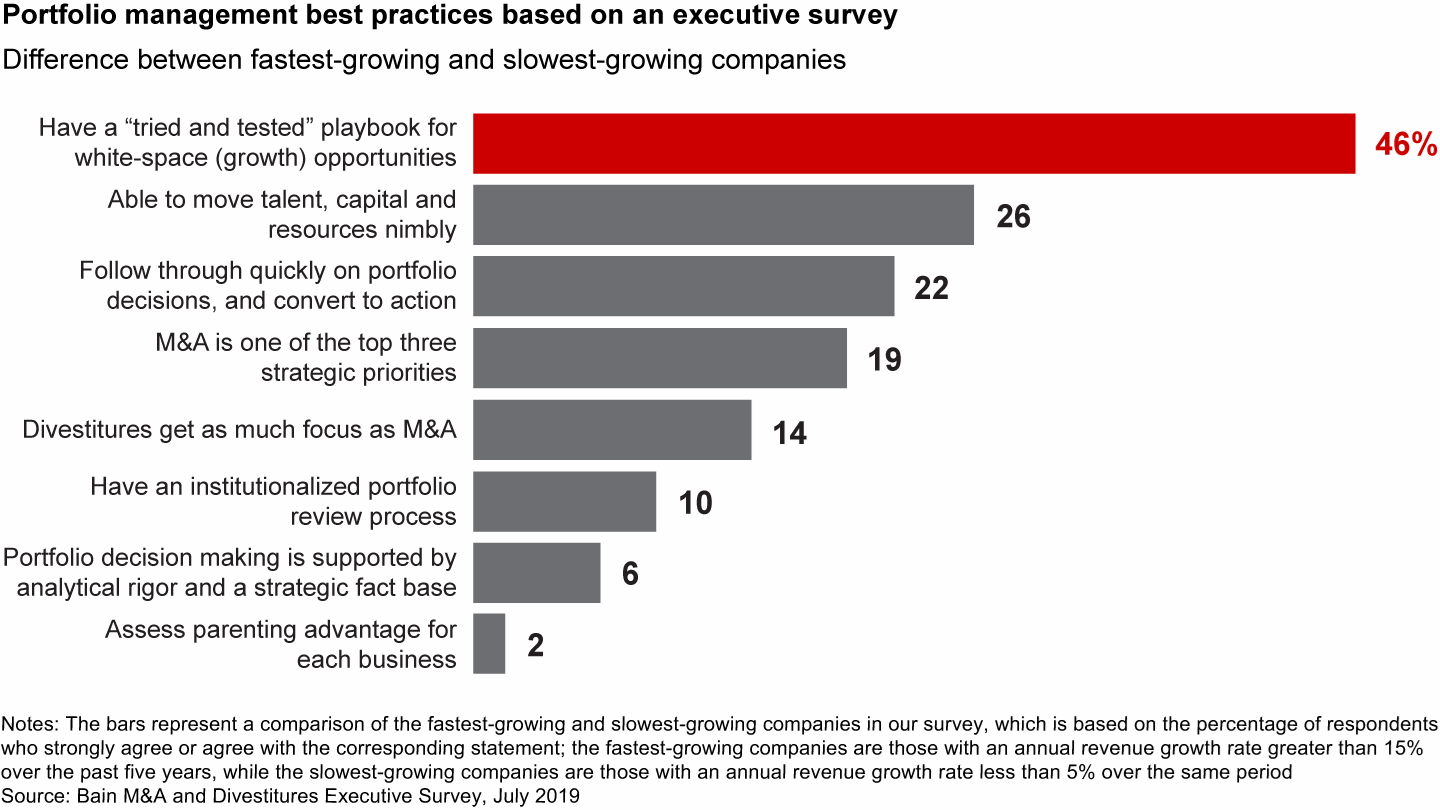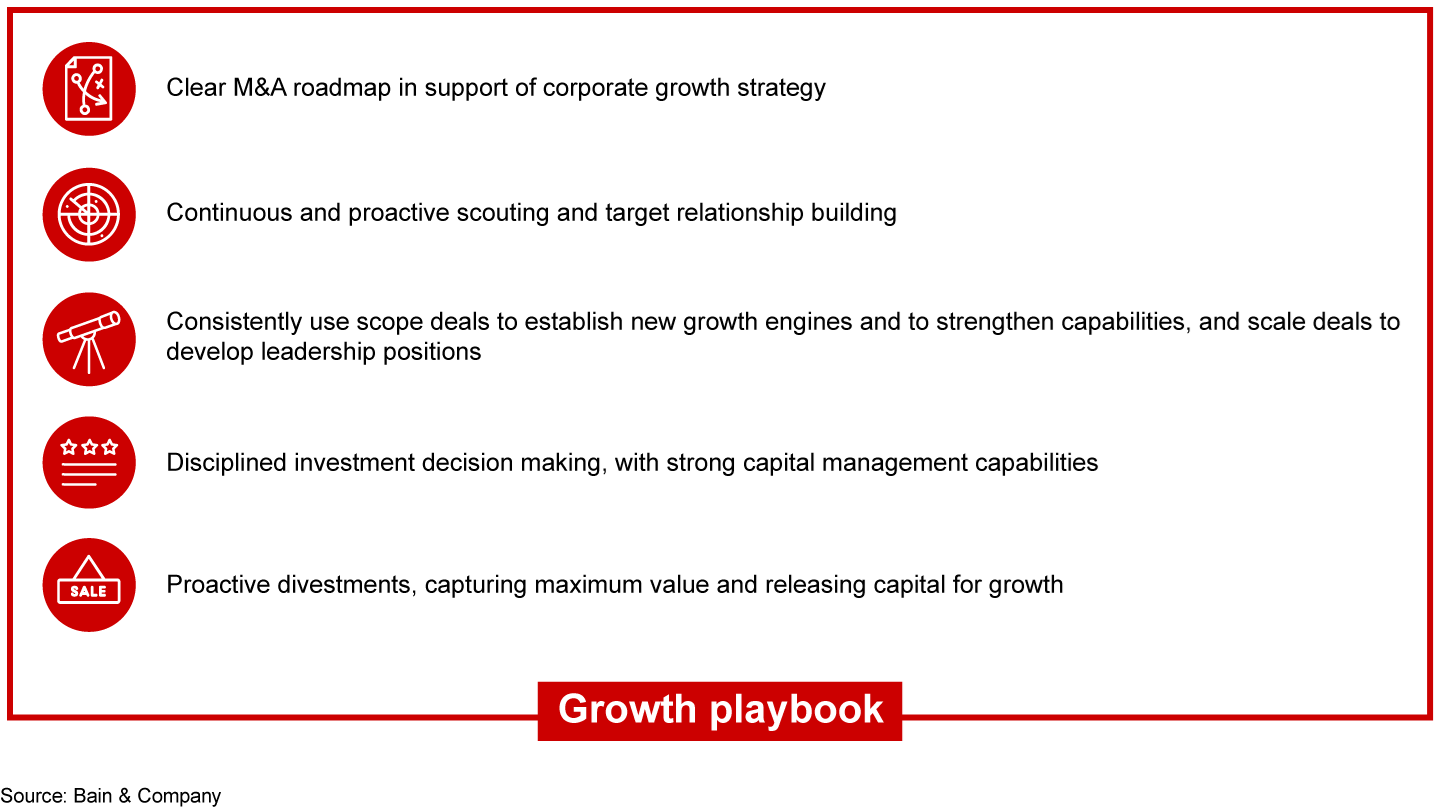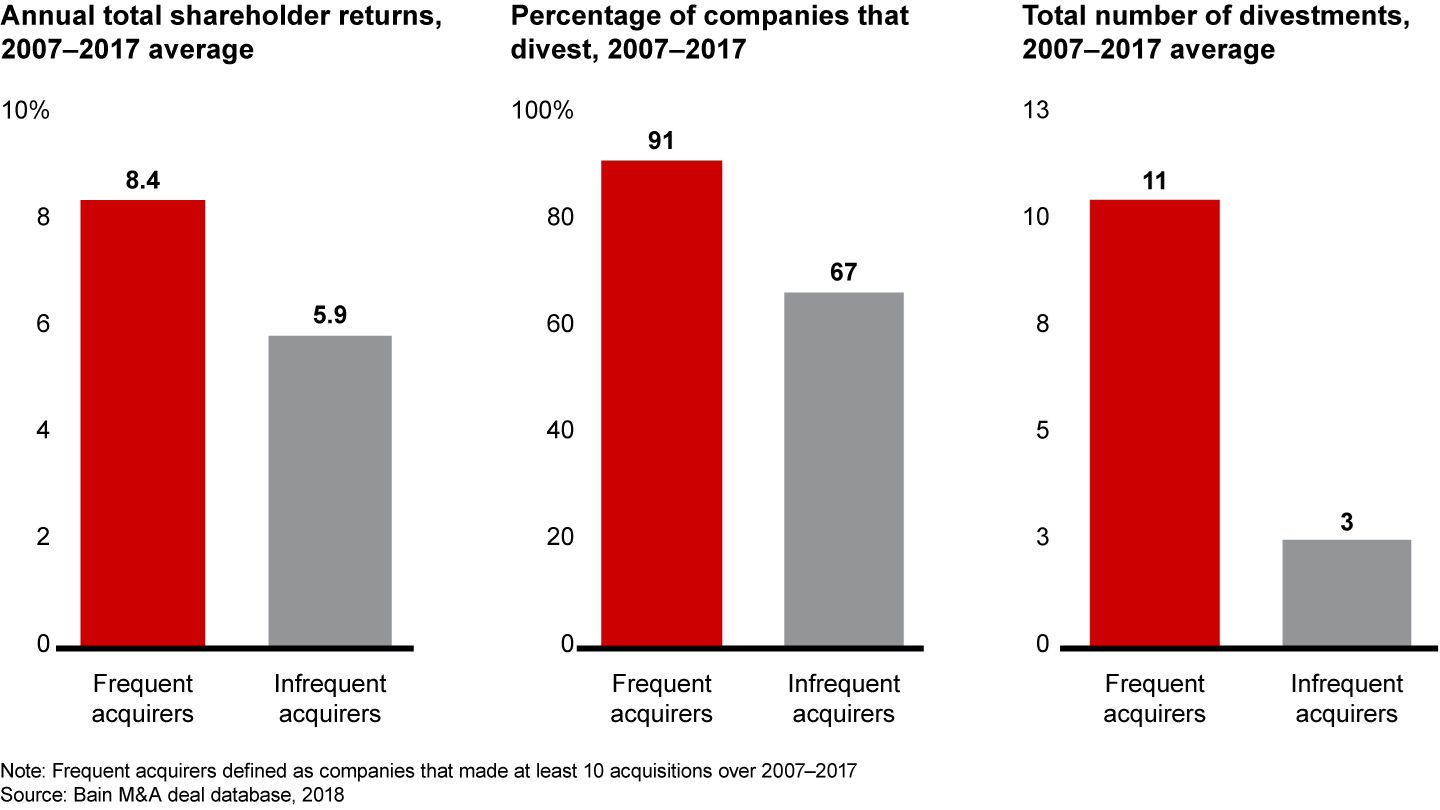Report

Executive Summary
- During a time of disruption and low growth, portfolio decisions are more important and challenging than ever.
- It is even more important now to base those decisions on fundamental strategic principles—leadership delivers superior economic returns, and unique capabilities should guide enter, invest and exit decisions.
- Faster-growing companies are able to systematically enter and accelerate new growth businesses using a repeatable M&A and divestiture playbook.
- Divestitures are an underutilized but indispensable tool for portfolio reshaping.
This article is Section 3 of Bain's 2020 Global Corporate M&A Report. Explore our latest annual M&A report here.
Invoke fundamental strategic principles for portfolio choices
In times of flux, it is critical to invoke two time-tested principles around portfolio choices.
- The first strategic principle is to play for leadership—that is, to have a clear route to achieving leadership in a correctly defined market.
- The second is to consider the joint value creation possible by combining your unique capabilities with those of the acquired companies.
Leadership position within correctly defined business boundaries is the route to superior economic returns. We say “correctly defined business boundaries” to account for the fact that economic returns are linked to different definitions of scale in different industries—for example, local or regional scale in banking, category leadership in pharmaceuticals and consumer products, and asset portfolios in traditional resource-based industries. In a tech-led world, leadership increasingly is determined by unique capabilities, such as customer loyalty and network effects, technology platform, and talent pool. Leadership matters because leaders have more time to react to disruptive trends, more resources to take action and more stability to ride out the change—this makes their businesses more sustainable.
As more companies start to look outside traditional business boundaries, it is good to remember that your probability of success is greater in sectors in which you can leverage your unique capabilities. These could be unique managerial, technological, financial, operational or cultural capabilities that enable you to achieve greater joint value than another owner. Your unique capabilities or gaps in desired capabilities should guide your portfolio targets—today and in the future.
Portfolio decisions are about the future and are inherently complex. Disruption compounds this complexity. More than 85% of executives we surveyed reported increased complexity in portfolio decision making compared with five years ago because of the uncertain evolution of existing and potential growth businesses.
M&A and divestitures fuel an ongoing growth playbook
From a recent senior executive survey on M&A and divestitures, we determined that faster-growing companies have a differentiated capability to target new growth opportunities through a tried and tested playbook involving M&A and divestitures (see Figure 3.1). They also have greater organizational agility and speed.
A white-space (or new growth) playbook is the biggest differentiator between fast-growing and slow-growing companies


Beyond the survey, we looked at a few companies that are known for their strong portfolio management capabilities and that have successfully adapted their portfolios over long periods. As you will note in the commentary below, what underpins their success is the role of M&A and divestitures to reshape the portfolio and consistently enter and expand into new growth businesses (see Figure 3.2).
Successful companies consistently use M&A and divestitures to enter and expand into new growth areas


L’Oréal has been using M&A and divestitures to reshape its global portfolio of leading brands over multiple decades. In fact, only one out of more than 30 brands (L’Oréal Paris) didn’t start out as an acquisition. L’Oréal’s strategy is to acquire emerging brands and use its parenting advantages—namely, marketing expertise, global distribution network, and research and development (R&D) capabilities—to scale the brands to global leadership. This has resulted in consistently expanding margins and revenue as well as global expansion.
In another example, Assa Abloy has made more than 200 acquisitions over the past 25 years to become a global leader in entry and access systems. Two elements of the company’s M&A capability stand out. It maintains a clear M&A roadmap in support of corporate strategy, building leadership positions by acquiring regional market leaders. The second element is its consistent use of scope deals to enter new growth markets and strengthen capabilities—this includes digital capabilities, such as its 2017 purchase of August Home, a smart lock company.
Portfolio evolution often requires adjustments or a redesign to the operating model over a long period of time. Said another way, the M&A roadmap decision often prompts other decisions about how to organize to run those assets. Plan for changes in your operating model alongside your portfolio roadmap.
Divestitures are an underutilized but indispensable tool for portfolio management
For companies with successful legacy businesses that are looking to invest in new growth engines, the decisions around divestitures can be the trickiest. That said, without divestitures, companies cannot truly free up the time, talent, energy and capital to invest in those new growth businesses.
In fact, our extensive research in M&A value creation over the past two decades shows that companies that actively manage their portfolios outperform. They typically are frequent acquirers, and almost 90% of them also divest (see Figure 3.3). These companies generally are the longer-term winners within their industries.
Frequent acquirers outperform—91% of them actively divest and do so significantly more than others


Axel Springer transformed its business from traditional to digital media through about 100 acquisitions and approximately 80 divestitures over the past decade. What’s notable is Axel Springer’s financial discipline—both in terms of investing and in timely divestitures that ensured prudent use of capital. Its M&A roadmap supported the strategic transformation to a digital media company through systematic dealmaking across three business areas: news/content, classifieds and marketing. All the while, the company made proactive divestments. This 2013 statement made by the CEO following the sale of a flagship media asset, leading women’s publication Bild der Frau, sums up the company’s approach to divestitures: “[W]e are not the market leader, by far not the market leader, in the women segment. And there was no realistic path to achieve that…. Bild der Frau is … generating in the sales process a lot of money with regards to the multiples. And we wanted also to get access to significant financial firepower for the projects that we have in mind with regard to the transformation of the company.”
New industry dynamics are creating new opportunities for M&A and divestiture practitioners. Scope deals, in particular, require a distinct approach across the entire M&A process, from screening to diligence to integration. In the following sections, we summarize what we have observed working alongside clients that have learned the rules for success with scope deals and divestitures.
This article is part of Bain’s 2020 Global Corporate M&A Report. Explore the contents of the report here or download the PDF to read the full report.